Xun Wu
The Era of Agentic Organization: Learning to Organize with Language Models
Oct 30, 2025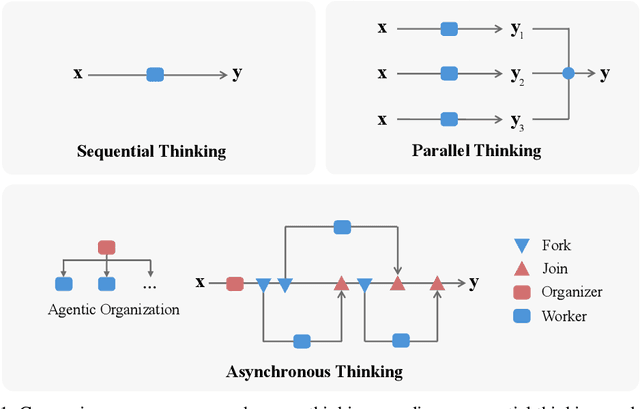



Abstract:We envision a new era of AI, termed agentic organization, where agents solve complex problems by working collaboratively and concurrently, enabling outcomes beyond individual intelligence. To realize this vision, we introduce asynchronous thinking (AsyncThink) as a new paradigm of reasoning with large language models, which organizes the internal thinking process into concurrently executable structures. Specifically, we propose a thinking protocol where an organizer dynamically assigns sub-queries to workers, merges intermediate knowledge, and produces coherent solutions. More importantly, the thinking structure in this protocol can be further optimized through reinforcement learning. Experiments demonstrate that AsyncThink achieves 28% lower inference latency compared to parallel thinking while improving accuracy on mathematical reasoning. Moreover, AsyncThink generalizes its learned asynchronous thinking capabilities, effectively tackling unseen tasks without additional training.
Towards Stable and Effective Reinforcement Learning for Mixture-of-Experts
Oct 27, 2025Abstract:Recent advances in reinforcement learning (RL) have substantially improved the training of large-scale language models, leading to significant gains in generation quality and reasoning ability. However, most existing research focuses on dense models, while RL training for Mixture-of-Experts (MoE) architectures remains underexplored. To address the instability commonly observed in MoE training, we propose a novel router-aware approach to optimize importance sampling (IS) weights in off-policy RL. Specifically, we design a rescaling strategy guided by router logits, which effectively reduces gradient variance and mitigates training divergence. Experimental results demonstrate that our method significantly improves both the convergence stability and the final performance of MoE models, highlighting the potential of RL algorithmic innovations tailored to MoE architectures and providing a promising direction for efficient training of large-scale expert models.
Beyond Demographics: Enhancing Cultural Value Survey Simulation with Multi-Stage Personality-Driven Cognitive Reasoning
Aug 25, 2025



Abstract:Introducing MARK, the Multi-stAge Reasoning frameworK for cultural value survey response simulation, designed to enhance the accuracy, steerability, and interpretability of large language models in this task. The system is inspired by the type dynamics theory in the MBTI psychological framework for personality research. It effectively predicts and utilizes human demographic information for simulation: life-situational stress analysis, group-level personality prediction, and self-weighted cognitive imitation. Experiments on the World Values Survey show that MARK outperforms existing baselines by 10% accuracy and reduces the divergence between model predictions and human preferences. This highlights the potential of our framework to improve zero-shot personalization and help social scientists interpret model predictions.
VisCodex: Unified Multimodal Code Generation via Merging Vision and Coding Models
Aug 13, 2025Abstract:Multimodal large language models (MLLMs) have significantly advanced the integration of visual and textual understanding. However, their ability to generate code from multimodal inputs remains limited. In this work, we introduce VisCodex, a unified framework that seamlessly merges vision and coding language models to empower MLLMs with strong multimodal code generation abilities. Leveraging a task vector-based model merging technique, we integrate a state-of-the-art coding LLM into a strong vision-language backbone, while preserving both visual comprehension and advanced coding skills. To support training and evaluation, we introduce the Multimodal Coding Dataset (MCD), a large-scale and diverse collection of 598k samples, including high-quality HTML code, chart image-code pairs, image-augmented StackOverflow QA, and algorithmic problems. Furthermore, we propose InfiBench-V, a novel and challenging benchmark specifically designed to assess models on visually-rich, real-world programming questions that demand a nuanced understanding of both textual and visual contexts. Extensive experiments show that VisCodex achieves state-of-the-art performance among open-source MLLMs and approaches proprietary models like GPT-4o, highlighting the effectiveness of our model merging strategy and new datasets.
Geometric-Mean Policy Optimization
Jul 28, 2025Abstract:Recent advancements, such as Group Relative Policy Optimization (GRPO), have enhanced the reasoning capabilities of large language models by optimizing the arithmetic mean of token-level rewards. However, GRPO suffers from unstable policy updates when processing tokens with outlier importance-weighted rewards, which manifests as extreme importance sampling ratios during training, i.e., the ratio between the sampling probabilities assigned to a token by the current and old policies. In this work, we propose Geometric-Mean Policy Optimization (GMPO), a stabilized variant of GRPO. Instead of optimizing the arithmetic mean, GMPO maximizes the geometric mean of token-level rewards, which is inherently less sensitive to outliers and maintains a more stable range of importance sampling ratio. In addition, we provide comprehensive theoretical and experimental analysis to justify the design and stability benefits of GMPO. Beyond improved stability, GMPO-7B outperforms GRPO by an average of 4.1% on multiple mathematical benchmarks and 1.4% on multimodal reasoning benchmark, including AIME24, AMC, MATH500, OlympiadBench, Minerva, and Geometry3K. Code is available at https://github.com/callsys/GMPO.
On-Policy RL with Optimal Reward Baseline
May 29, 2025Abstract:Reinforcement learning algorithms are fundamental to align large language models with human preferences and to enhance their reasoning capabilities. However, current reinforcement learning algorithms often suffer from training instability due to loose on-policy constraints and computational inefficiency due to auxiliary models. In this work, we propose On-Policy RL with Optimal reward baseline (OPO), a novel and simplified reinforcement learning algorithm designed to address these challenges. OPO emphasizes the importance of exact on-policy training, which empirically stabilizes the training process and enhances exploration. Moreover, OPO introduces the optimal reward baseline that theoretically minimizes gradient variance. We evaluate OPO on mathematical reasoning benchmarks. The results demonstrate its superior performance and training stability without additional models or regularization terms. Furthermore, OPO achieves lower policy shifts and higher output entropy, encouraging more diverse and less repetitive responses. These results highlight OPO as a promising direction for stable and effective reinforcement learning in large language model alignment and reasoning tasks. The implementation is provided at https://github.com/microsoft/LMOps/tree/main/opo.
Think Only When You Need with Large Hybrid-Reasoning Models
May 21, 2025Abstract:Recent Large Reasoning Models (LRMs) have shown substantially improved reasoning capabilities over traditional Large Language Models (LLMs) by incorporating extended thinking processes prior to producing final responses. However, excessively lengthy thinking introduces substantial overhead in terms of token consumption and latency, which is particularly unnecessary for simple queries. In this work, we introduce Large Hybrid-Reasoning Models (LHRMs), the first kind of model capable of adaptively determining whether to perform thinking based on the contextual information of user queries. To achieve this, we propose a two-stage training pipeline comprising Hybrid Fine-Tuning (HFT) as a cold start, followed by online reinforcement learning with the proposed Hybrid Group Policy Optimization (HGPO) to implicitly learn to select the appropriate thinking mode. Furthermore, we introduce a metric called Hybrid Accuracy to quantitatively assess the model's capability for hybrid thinking. Extensive experimental results show that LHRMs can adaptively perform hybrid thinking on queries of varying difficulty and type. It outperforms existing LRMs and LLMs in reasoning and general capabilities while significantly improving efficiency. Together, our work advocates for a reconsideration of the appropriate use of extended thinking processes and provides a solid starting point for building hybrid thinking systems.
Reward Reasoning Model
May 20, 2025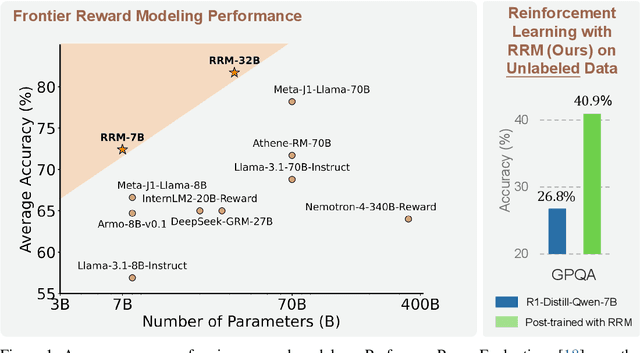
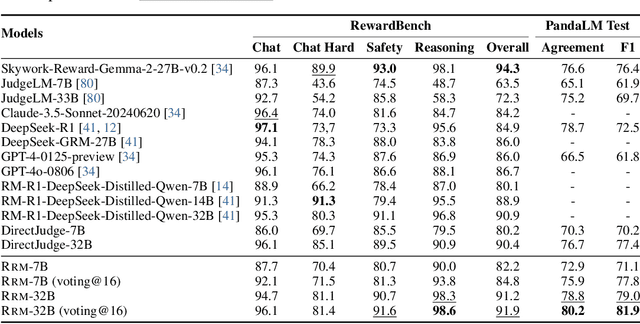
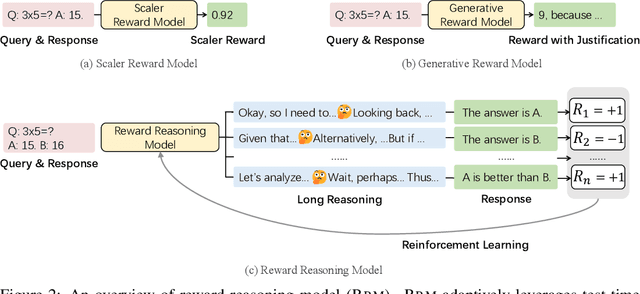

Abstract:Reward models play a critical role in guiding large language models toward outputs that align with human expectations. However, an open challenge remains in effectively utilizing test-time compute to enhance reward model performance. In this work, we introduce Reward Reasoning Models (RRMs), which are specifically designed to execute a deliberate reasoning process before generating final rewards. Through chain-of-thought reasoning, RRMs leverage additional test-time compute for complex queries where appropriate rewards are not immediately apparent. To develop RRMs, we implement a reinforcement learning framework that fosters self-evolved reward reasoning capabilities without requiring explicit reasoning traces as training data. Experimental results demonstrate that RRMs achieve superior performance on reward modeling benchmarks across diverse domains. Notably, we show that RRMs can adaptively exploit test-time compute to further improve reward accuracy. The pretrained reward reasoning models are available at https://huggingface.co/Reward-Reasoning.
MH-MoE: Multi-Head Mixture-of-Experts
Nov 26, 2024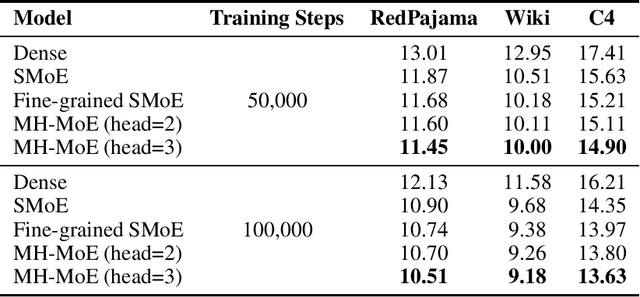
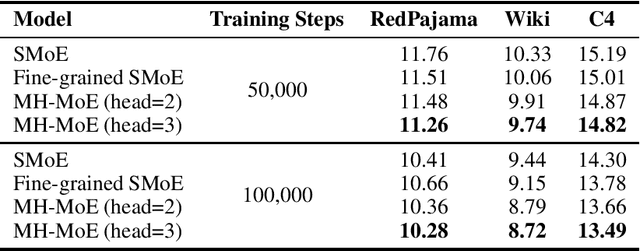
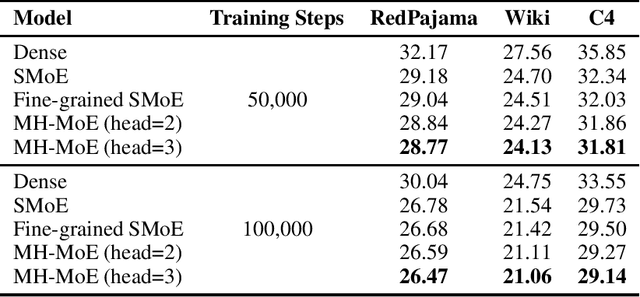

Abstract:Multi-Head Mixture-of-Experts (MH-MoE) demonstrates superior performance by using the multi-head mechanism to collectively attend to information from various representation spaces within different experts. In this paper, we present a novel implementation of MH-MoE that maintains both FLOPs and parameter parity with sparse Mixture of Experts models. Experimental results on language models show that the new implementation yields quality improvements over both vanilla MoE and fine-grained MoE models. Additionally, our experiments demonstrate that MH-MoE is compatible with 1-bit Large Language Models (LLMs) such as BitNet.
Textual Aesthetics in Large Language Models
Nov 05, 2024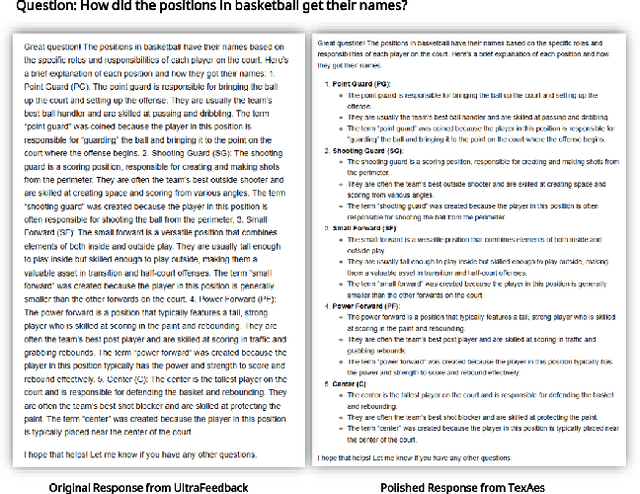
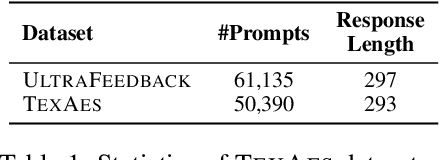
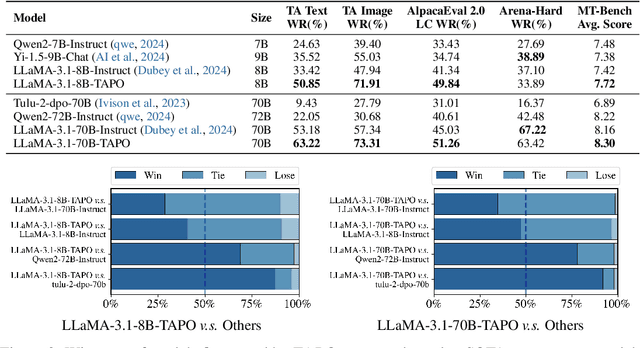
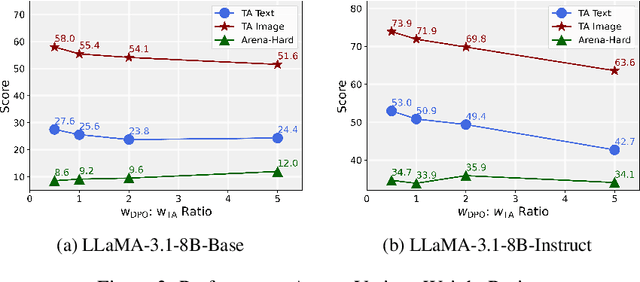
Abstract:Image aesthetics is a crucial metric in the field of image generation. However, textual aesthetics has not been sufficiently explored. With the widespread application of large language models (LLMs), previous work has primarily focused on the correctness of content and the helpfulness of responses. Nonetheless, providing responses with textual aesthetics is also an important factor for LLMs, which can offer a cleaner layout and ensure greater consistency and coherence in content. In this work, we introduce a pipeline for aesthetics polishing and help construct a textual aesthetics dataset named TexAes. We propose a textual aesthetics-powered fine-tuning method based on direct preference optimization, termed TAPO, which leverages textual aesthetics without compromising content correctness. Additionally, we develop two evaluation methods for textual aesthetics based on text and image analysis, respectively. Our experiments demonstrate that using textual aesthetics data and employing the TAPO fine-tuning method not only improves aesthetic scores but also enhances performance on general evaluation datasets such as AlpacalEval and Anera-hard.
 Add to Chrome
Add to Chrome Add to Firefox
Add to Firefox Add to Edge
Add to Edge